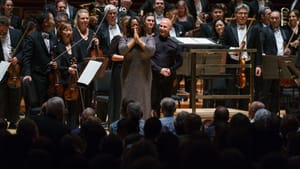Stay in the Loop
BSR publishes on a weekly schedule, with an email newsletter every Wednesday and Thursday morning. There’s no paywall, and subscribing is always free.
We're still talking about "women" composers. Can we just not?
How many female composers does it take to change a narrative?

A few weeks ago, the WRTI-FM website ran a story reflecting on the constancy and increasing influence of women in classical music. The story was framed around Women’s History Month and designed to highlight the station’s growing catalog of music written by women, and so the story followed a trope—a newish trope, but still, a trope: “We don’t need to put women in a spotlight as if they’re a novelty because they’ve been here all along!” Which, albeit true, is a “look at the unicorn” angle in its own right. Heck, reserving this story for March was a bit...cynical, wasn’t it?
A tempered view
If that sounds negative or hypercritical of the story or its reason for being, that’s only because I wrote it. I get why it was timed as it was; I am glad the story exists, and turning people on to great music is a privilege I take very seriously. What carries the story along are the voices of amazing leaders in the city’s classical music sphere describing the rich history of women’s contributions to the genre and the industry, not only as composers but as performers, teachers, conductors, philanthropists, and founders. They celebrate those contributions while acknowledging the cultural limitations (patriarchy, misogyny, you know the very real narrative) that have made the road from obstacles and marginalization to considerably fewer obstacles and less marginalization.
The story reflects a tempered view of women’s influence in classical music, one that is optimistic that the more inclusive stages and programs we’ve gotten to see in the past many seasons (thank you, PhilOrch and Mimi Stillman’s Dolce Suono for leading the charge on that!) will flourish. But it also cast a wary eye on the male privilege woven into the fabric of the classical music industry, even as it acknowledged the extraordinary efforts of those women who have paved the way.
Spilled ink, brothers, and courtesans
“I think we would strive to say we play music on the basis of it being great music, regardless of who or what the person looks like,” said Juliette Kang, associate principal violin of the Philadelphia Orchestra. “But in fact, representation does matter.”
And she is right. It is important to play great music because it is great. It is just as important to play music written by all kinds of people. And it is important not to be condescending, exploitative, or otherwise offensive when we program, perform, or listen to great music by people who are not white men.
Why does that still feel like a double bind?
In a Zoom call, Mimi Stillman and I traded our favorite works for the flute by women composers, and the conversation turned to the Concertino by Cecile Chaminade, one of the first pieces of the standard repertoire that every flutist learns. As we talked, I couldn’t help but remark to myself how, as a 12-year-old learning that piece, it never occurred to me that Chaminde’s female-ness was out of the ordinary. No one pointed at her name on the cover of my score and said, “Hey, that’s a woman, and that means she's important or unusual.”
I was blissfully ignorant of the history of women who came before me whose husbands are said to have spilled ink on their scores (Germaine Tailleferre) or whose work was published under her brother’s name (Fanny Mendelssohn) or who were assumed posthumously to have been courtesans (Barbara Strozzi). Those were no longer realistic worries for me, because so many women had done the excruciating work of standing on their own in the field already.

The frame we don’t need?
It makes me wonder: When is it OK to take off the training wheels? Or maybe it’s scaffolding? Or a box or a tent we’re all living in together? I’m not sure what the right metaphor is, but it’s feeling less and less like a glass ceiling or a fish bowl (or some other image from a classic “male gaze” essay). It’s also feeling crowded and unnecessary. What I mean is, have we reached a saturation point where we no longer have to talk about ourselves (I’m including myself here now, because I’m a woman and a classical musician and, to be honest with you, I’m having some strong feelings of impatience and restlessness about this right now) in an old, rusted-out, cracked frame that someone else built? It just seems, sometimes, perhaps, unhelpful to tell the stories about today’s classical musicians entirely within a frame of their marginalization in the past. Even to set our stories in a modernist narrative—“Women have been here all along! (but we’re talking about it because it’s March)” —is to legitimize and perpetuate and accommodate the very White Guy Privilege narrative that we’re all trying to get out from under.
What I mean is, what if those training wheels—or scaffolding or box or tent—suddenly fell away, and all us players, composers, and teachers who enjoy the earned pride and confidence that comes from growing a critical mass through decades of effort, mentorship, and inclusion...stood on our own? At what point might we simply declare that the glass ceiling no longer exists and the training wheels are obsolete? In these conditions, we are empowered to remove the modifiers from the job title. No longer modified, marginalized, or othered by language, perception—and value—follow.
The stories that are told for and about women in music, well-meaning as they are, often feel as if they exist somewhere far beyond everyday life in the practice room and the concert hall, where composers and players of every stripe are focused on presenting music that captivates and inspires audiences. The “look at these amazing women composers!” narrative is akin to “wow, you throw a ball pretty good for a girl”: antiquated and out of place in 2021.
Image description: A photo of composer Valerie Coleman, a Black woman wearing a sparkling silver dress, conductor Yannick Nézet-Séguin, a white man wearing a black jacket, and a crowd of Philadelphia Orchestra musicians. They’re all standing happily in front of an applauding crowd at Verizon Hall.
Image description: A photo of composer Vivian Fung, an Asian woman wearing a lacy blue dress, and Yannick Nézet-Séguin, a white man wearing a white jacket. They stand on a stage, smiling with their hands clasped together, facing the audience off-camera. Orchestra musicians sit around them.
Sign up for our newsletter
All of the week's new articles, all in one place. Sign up for the free weekly BSR newsletters, and don't miss a conversation.

 Meg Ryan
Meg Ryan